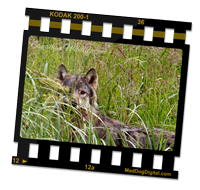Welcome to Canadian Wildlife
--
The
wild side of Canada™ |
Copyright notice: All text, layout,
images and graphical representations are copyright ©
2010
Mad Dog
Digital and may not be copied, reproduced or
transmitted without the written consent of
Mad Dog
Digital. Please contact us for more
information |
|
|
|
|
Details about:
Grey
Timber Wolf in Canada & Alaska (USA) |
| |
 The
Grey Timber Wolf The
Grey Timber Wolf
The
Gray Wolf, also
known as a Timber Wolf, is woven into our own
history through stories, folklore and fantasy.
During the mid-1900’s there were many records and
stories of wolves attacking people, however in
recent times there have been very few North American
reports of people being killed by wolf attacks.
According to statistics, more people are killed by
hippopotamuses every year than by wolves.
Gray Wolves stand
up to 37” (95 cm) tall at the shoulders, measure up
to 80” (200 cm) from nose to the tip of the tail and
have a maximum average weight of 80 lb (36 kg).
Usually a grizzled gray, the coloration range
includes white, beige, red, brown and black. |
| |
 |
| |
| DNA research has shown that wolves have undergone
very little evolutionary change in the last 300,000
years. Well adapted to their environment, slight
webbing between the toes, special blood vessels in
the pads and strong claws allow them to walk through
snow and on ice with relative ease. Additionally, a
two layer coat keeps wolves protected from the
environment. Tougher, longer hairs repel dirt and
water while the undercoat, being water-resistant, is
the insulator that keeps them warm. This two layer
coat is such a good insulator that even during snow
and blizzard conditions a wolf will curl up,
covering its nose and paws with its tail and wait
out the storm warm and content. During the spring
and summer, this undercoat is shed by rubbing
against trees and rocks. |
| |
 |
| |
| In late spring to early summer, female wolves will
give birth to an average litter of 5 - 6 wolf pups.
When born, these pups weigh less than 1 lb (450gr),
are deaf, blind and completely dependent on the
mother. By 5 weeks of age, they are venturing up to
1 mile (1.6 km) from the den entrance and by 4
months, some of the stronger pups accompany the
adult wolves on hunts. Wolves are very family
oriented living in packs averaging 4 - 7 wolves,
usually consisting of parents, new pups and immature
wolves between 1 – 3 years old. Once reaching
maturity (between 3 - 4 years old) most wolves will
break away from the pack and find a mate to start
their own pack. |
| |
 |
| |
Lone wolves are either usually older wolves driven
from the pack or young wolves that have broken away
from the pack and are looking for a mate.
In most areas in the Canadian wilderness, the wolf
pack territory is about 80 sq. mi (210 sq km). As a
pack, they usually travel and cover about 10% of
this area every day, however almost 50% of their
time is spent and is focused on only about 15 sq mi
(38 sq km). While capable of sprinting at up to 40
mph (km/h), their main reliance, both when
travelling their territory and when hunting prey is
on their stamina. Rarely will wolves give a high
speed chase to potential prey for more than 1,000
yards (915 m). With such a large territory to cover,
special scent glands in a wolf’s paw leaves a scent
trail on the ground so they know if they’ve been at
a spot already. Combined with howling, it is these
scent markings that tell other wolves that this is a
claimed territory. |
| |
 |
| |
| Wolves exhibit hunting traits that are unique to
their species. Communication amongst a single pack
is achieved through the use of a variety of barks,
growls, yelps and howls, however, unlike other
carnivorous pack animals, they generally do not use
sounds to organize and work together on a hunt.
Furthermore, when chasing & hunting prey, wolf packs
with more males tend to hunt larger, slower animals
while packs with more females tend to hunt faster,
smaller animals. While being primarily carnivorous,
it is found that wolves tend to evolve towards a
more vegetarian based diet with reports of wolf
packs attacking watermelon patches and plantations.
|
| |
|
Return to our main animals in
Canada page |
| |
 |
| |
| |
 |
| |
|
|
|



